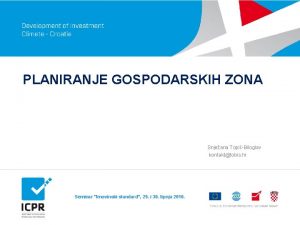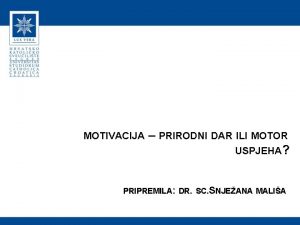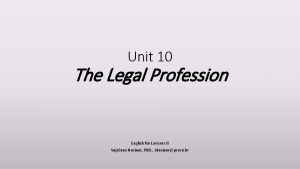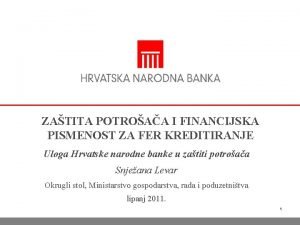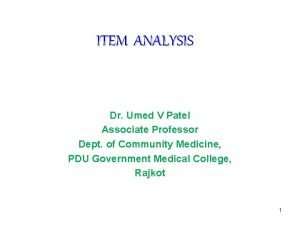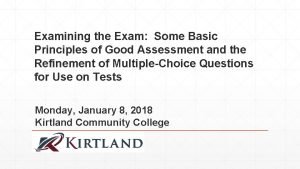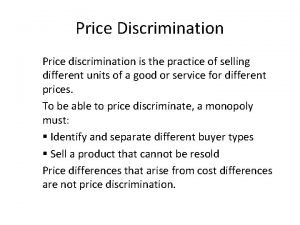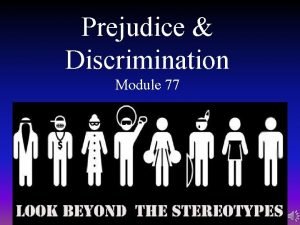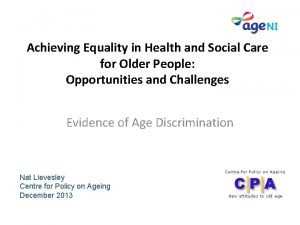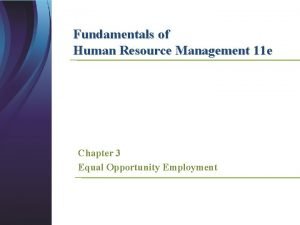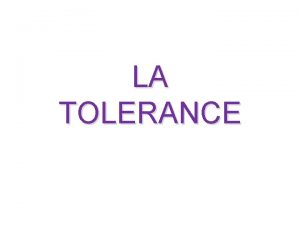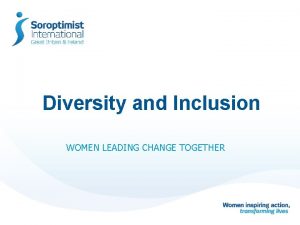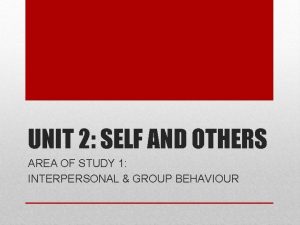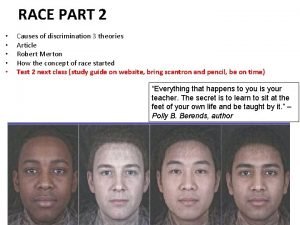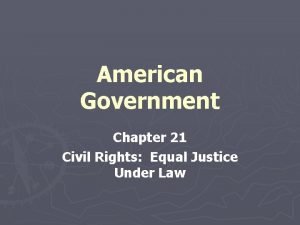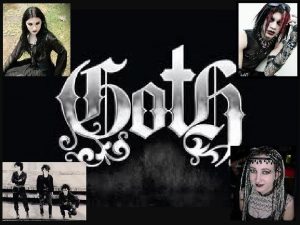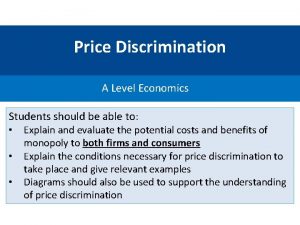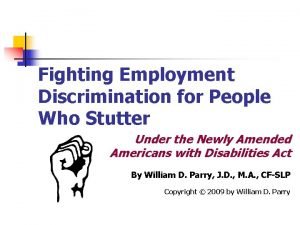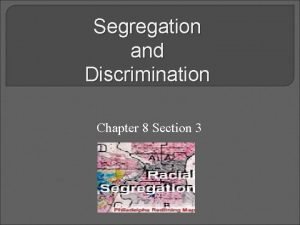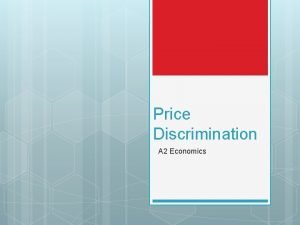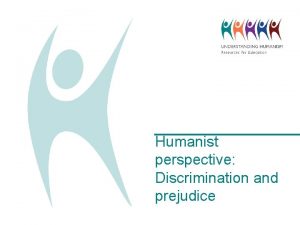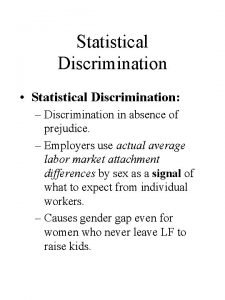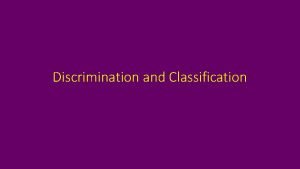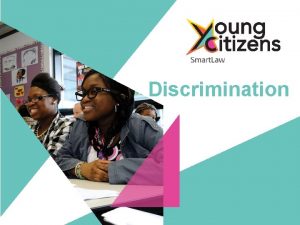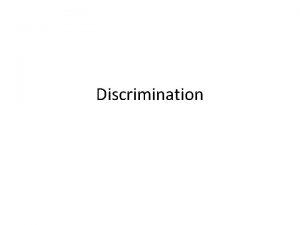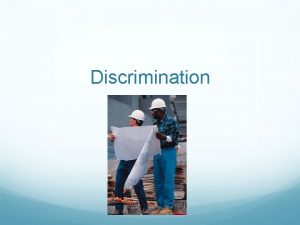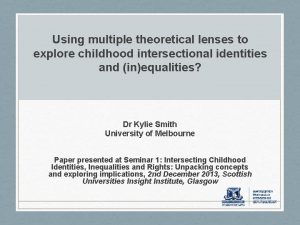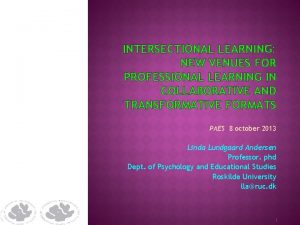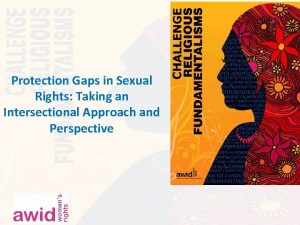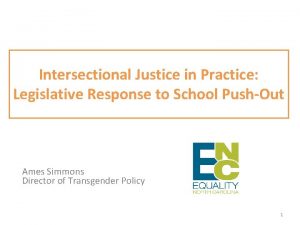Intersectional discrimination EU vs US perspective Dr Snjezana





































- Slides: 37

Intersectional discrimination –EU vs US perspective Dr. Snjezana Vasiljevic Columbia Law School Columbia University Dr. Snjezana University of Vasiljevic Zagreb, Faculty of Law svasilje@pravo. hr 04/23/2012 1

STRUCTURE OF DOCTORAL THESIS INTRODUCTION (divided by chapters) hypotheses Comparativ e research Limitations Theoretica l framework Conclusion s 04/23/2012

HYPOTHESES EU recognition of multiple discrimination Consistent implementatio n of antidiscrimination law in Member States Hierarchy of equality 04/23/2012

VARIABLES Inconsistent equality mechanisms No unique antidiscrimination policy No effective remedy 04/23/2012

THEORETICAL FRAMEWORK FEMINIST THEORY BLACK FEMINIST THEORY (CRITICAL DISCOURSE ) THEORY OF DIFFERENC E 04/23/2012

FEMINIST THEORIES No unified theoretical model applicable Different forms of oppression lead to the different forms of discrimination & violence against marginalised ground (Young, 2005) Different stereotypes (racism, sexism, heterosexism) Universal forms, standards and politics – unacceptable (Mac. Kinnon, Dworkin) Other theories (biological, cultural, evolutionist) – aggression/domination – social/genetic 04/23/2012

BLACK FEMINIST THEORIES – CRITICAL DISCOURSE White feminism ignored the experience of black women (King, 1998) White feminism forgot the notion of adjective “white” (Robinson, 2000) White feminism uses the view of white women (Crenshaw, 1989) 04/23/2012

THEORY OF DIFFERENCE Judith Butler (1990) more difference we have in society – more possibility for oppression different experiences created by individuals (gendered racism) intersectional experiences (forced sterilization, ethnic rapes, honour crimes) 04/23/2012

COMPARATIVE ANALYSIS Document analysis Statistical data Interviews Court cases (ECJ, ECHR, national courts) Comparative legal analysis at different levels (international, EU, Co. E, National – GB, Germany, Croatia) Literature review 04/23/2012

LIMITATIONS LACK OF CASE LAW LACK OF APPROPRIAT E LEGAL FRAMEWORK LACK OF RESEARCH LACK OF LITERATURE 04/23/2012

RESULTS/CONCLUSION Lack of legal certainty (hierarchy of equality) Lack of trust (legislation is partial and not consistent) Lack of legal cases (ECJ, ECHR, national courts) Lack of education Lack of raising awareness Lack of reporting (e. g. protocol/rules of conduct in cases of discrimination) 04/23/2012

The principle of equality “Democracy arises out of the notion that those who are equal in any respect are equal in all respects; because men are equally free, they claim to be absolutely equal (Aristotle, Politics)”. 12 04/23/2012

The principle of equality An equal society recognizes people’s different needs, situations and goals and removes the barriers. This definition recognizes, as the current EU legal framework does not, that factors such as gender, age, disability, ethnicity, religion and sexual orientation can interact to create multiple or intersectional disadvantage. The fact that the current legislation does not expressly address multiple or intersectional discrimination leaves the most disadvantaged members of society, unable to challenge the discrimination they experience. 13 04/23/2012

The principle of equality –some problems hierarchy of equality no recognition of “intersectionality” between two or more different kinds of discrimination The consequence of overlapping two forms of discrimination is usually double discrimination which significantly strikes the most vulnerable groups. Black, ethnic minority and migrant women tend to be invisible in society in terms of their representation, their contribution and recognition of their needs. 14 04/23/2012

INTERSECTIONALITY The term was first used by Crenshaw (1989) She used the picture of an intersection of streets “Discrimination, like traffic through an intersection, may flow into one direction and it may flow into another. If an accident happens at an intersection it can be caused by cars travelling from any number of directions, and sometimes, form all of them. Similarly, if a black woman is harmed because she is in the intersection, her injury could result from sex discrimination or race discrimination (Crenshaw, 1989). ” 04/23/2012

Intersectionality “multiple discrimination” describes situations where a person can be subjected to discrimination on more than one ground. Compound discrimination describes a situation where a person suffers discrimination on the basis of two or more grounds at the same time and where one ground adds to discrimination on another ground (in other words one ground gets compounded by one or more other discrimination grounds). Intersectional discrimination refers to a situation where several grounds operate and interact with each other at the same time in such a way that they are inseparable. 16 04/23/2012

Intersectionality The most recognizable examples of intersectional oppression are often the most tragic: ethnic or race based violence against women Example: women suffering ethnic/race and gender discrimination during the war in Rwanda and Bosnia there are so many stories about the war in Croatia & Bosnia but so little about suffering of women; was it only ethnic cleansing or sexual abuse for the purpose of deterrance or both? 17 04/23/2012

Intersectionality If we take into consideration different pieces of legislation in EU countries, institutional mechanisms including equality bodies as well as nongovernmental-organizations we can conclude that despite the recognition reflected in antidiscrimination and equal treatment legislation, multiple discrimination, as a concept remains obscure. The main problem is that most institutions and organizations concerned with anti-discrimination legislation and policy are still focused on the single ground approach. Minority women seem to be most vulnerable to multiple discrimination. 18 04/23/2012

Intersectionality Lack of research, registered complaints and crosssectional data contribute to the continued invisibility of the phenomenon of multiple discrimination for other disadvantaged groups as well: older ethnic minorities, black persons with a disability, etc. Multiple discrimination happens in all spheres of social life. The labor market, appears to be the sector where multiple discrimination occurs most often. In many MS, the scope of anti-discrimination legislation outside employment and occupation is limited to only gender and race/ethnic origin. New phenomenon – mobbing, bullying at the workplace (good example of multiple discrimination/intersection of sex, age, sexual orientation, disability, etc. ) 19 04/23/2012

Is EU law capable of addressing multiple and intersectional discrimination yet? Primary and secondary EU law (Article 13 of Amsterdam Treaty, Equal Treatment Directives) EU legal framework is lacking a clear definition of intersectional discrimination. However, it is possible to read the legal framework in a way that made it possible to offer adequate solutions to intersectional discrimination. 20 04/23/2012

Is EU law capable of addressing multiple and intersectional discrimination yet? Despite this EU directives do recognize that different grounds can intersect, in relation to gender the preamble to both the Race and the Employment Equality Directives stipulate that “in implementing the principle of equal treatment, the Community should, in accordance with Article 3 (2) of the Treaty, aim to eliminate inequalities, and to promote equality between men and women, especially since women are often the victims of multiple discrimination. ” Member States do not fully address Multiple Discrimination. 21 04/23/2012

EU member states addressing multidimensional problems of equality? Austrian, German, Spanish and Romanian law contain the only specific provisions in the EU Member States’ legislation on how to handle multiple discrimination. A limited amount of case law has emerged on the issue of EU. Case law from Denmark, Latvia, Sweden, Ireland the UK demonstrate that multiple discrimination cases are identified and do reach dispute resolution bodies. 22 04/23/2012

New devlopments in EU law Treaty of Lisbon – article 17. “. . . any disrimination on the grounds of nationality is forbidden!” Treaty of Lisbon – article 17 a. . . ”Council after obtaining a consent of the Parliament, may take appropriate action to combat discrimination based on sex, racial or ethnic origin, religion or belief, disability, age or sexual orientation. ” Treaty of Lisbon – social policy. . . working conditions, labor market, protection of workers, equal opportunities, equal pay for equal work, etc. . . (article 136 -142) 23 04/23/2012

RACE, ETHNICITY, COLOUR, NATIONAL MINORITIES Religion is expressly protected as separate ground under EED However, an alleged victim of religious discrimination may have an interest in associating religion with the ground of race because, as EU law currently stands, protection from race discrimination is broader in scope than protection from religious discrimination Example: Sejdic and Finci V. Bi. H, 2009 (105) 04/23/2012

How legal norms on intersectional discrimination can be applied to Eastern Europe? The issue of concern is whether Western European approach to anti-discrimination policy is different from the one existing in Eastern European countries? Concerning the current equality legal framework in Eastern European countries and the state of implementation of European Union Directives, the answer is positive. Specialized bodies constructed for that specific purpose have not been consistent and effective in implementing measures defined by existing legislation neither proven to be coherent with new standards introduced by European Community law. 25 04/23/2012

How legal norms on intersectional discrimination can be applied to Eastern Europe? What is more significant and worries those who established anti-discrimination framework is that Eastern European countries fail in harmonizing domestic laws in the field of race and gender with each other. Gender equality norms can be described as “gender -sensitive” norms but are only gender-sensitive in terms of offering a general framework for action combating gender discrimination 26 04/23/2012

How legal norms on intersectional discrimination can be applied to Eastern Europe? One of the biggest gaps in the existing legislation of former and current accession countries is the lack of emphasize on individual rights protection The lack of full understanding of the basic concepts of equality - equality legislation in the CEE full of gaps and definitions, often literally adopted from the EU legislation. No recognition of multiple discrimination in practice 27 04/23/2012

How legal norms on intersectional discrimination can be applied to Eastern Europe? The possible consequence of such a wrongdoing is non-implementation of recently adopted norms of gender equality due to reason that judges and national machineries responsible for its implementation do not know how to apply certain rules 28 04/23/2012

Justification defence Presumption of discrimination Witness statements Statistical evidence Questionnaire Situation testing Proving discrimination 04/23/2012

PROVING DISCRIMINATION Situation testing (Roma case, Gothenburg case) Questionnaire (prituzba poslodavcu) Statistical evidence (Saymor Smith & Perez, C-167/97, employment rights and privileges …if available statistics indicated that a considerably smaller percentage of women than men were able to satisfy the condition Witness statements and other documents (Romanian ADA allows the use of audio and video recordings, Hungary: the same case may be litigated in different forums…courts, equality commission, ombudsperson…)) Prima facie cases: establishing presumption of discrimination (Feryn, Enderby) Use by defendants of the “justification defense” – Defendants may argue that the principle of freedom of contract should override provisions promoting equality. ECJ holds that EU equal pay provisions override freedom of contract – equal pay is protected even if individual and collective agreements specify unequal compensation, Case C-43/75, Defrenne Rebutting the “justification defense” – victims can answer the questions arising from the definition of exceptions under EU law 30 04/23/2012

EXAMPLE OF CROATIA –LEGAL FRAMEWORK Gender equality act (GEA), 2003 Domestic violence act, 2003 Same-sex unions act, 2003 Gender Equality Act, 2008 Law on supression of all forms of discrimination, 2008 (entered into force on 1 January 2009) Other laws prohibiting discrimination: Labour law, Family law, Criminal law, Media law, Law on scientific work and high education 31 04/23/2012

EXAMPLE OF CROATIA – INSTITUTIONAL MECHANISMS Governmental Office for Equal Opportunities Parliamentary Committee for Human Rights Ombudsperson for Gender Equality Ombudsperson for people with disabilities Ombudsperson for children 32 04/23/2012

EXAMPLE OF CROATIA – problems of Gender Equality Act/Anti-discrimination Act Some important areas where discrimination occurs are not included into GEA (health, education, family life, prostitution, trafficking, rural areas, public life, enterpreneurship, etc. ) Definition of multiple discrimination does not exist in GEA!!! But multiple discrimination is defined by Antidicrimination Law New concepts are not completely defined Other forms of discrimination are not included (economic violence, glass ceiling, multiple discrimination, etc. ) 33 04/23/2012

EXAMPLE OF CROATIA – problems of Gender Equality Act provisions on burden of proof have not been implemented! Lack of effective sanctions for infringment of GEA!!!! But, now in screening process is evident that existing gender equality legislation is full of gaps and not completely harmonised with EU law Consequence – non implementation in practice! It is evaluated that GEA (2003) is completely harmonised with EU law Abolished in January 2008, by the decision of Constitutional Court (absence of qualified majority) 15 July 2008, new GEA entered into force (slightly better than the previous one! 34 04/23/2012

EXISTING PROBLEMS Legal value of gender equality legislation Existing discrimination of women Lack of court practice Existance of multiple discrimination: position of Roma an other ethnic minorities women & trafficking of women Neccessity for new unique anti-discrimination law prohibiting disccrimination on all grounds, taking into acount the problem of intersectional/multiple discrimination, providing sanctions –new antidiscrimination law entered into force on 1 january 2009! 35 04/23/2012

PRELIMINARY REFERRALS BASED ON COLEMAN CASE C 303/06 I. DOES THE CASE FALL UNDER EU LAW? Yes 1. Are the parties involved covered? Yes: an employee and her employer 2. Is the protected ground covered or does the issue have relevance for a protected ground? Yes: disability; the question is whether or not harassment in association with disability is covered II. IS THE FIELD COVERED? Yes: employment. 04/23/2012

PRELIMINARY REFERRALS BASED ON COLEMAN CASE C 303/06 III. DOES EUROPEAN LAW APPLY TO THE WHOLE OR GREATER PART OF THE PERIOD IN WHICH THE DISCRIMINATION TOOK PLACE? Yes, harassment occurred after the EED had been transposed into national law IV. IS THERE A LEGAL ISSUE THAT NEEDS INTERPRETATION BY THE ECJ (is the key concept correctly transposed or not transposed at all)? Yes: is the mother facing harassment on the basis of her association with disabled child? Definition of a protected ground is at issue. 04/23/2012
 Snježana husinec
Snježana husinec Snježana vasiljević
Snježana vasiljević Snjezana leovac
Snjezana leovac Snjezana maric
Snjezana maric Link budget analysis
Link budget analysis Snježana topić biloglav
Snježana topić biloglav Snježana mališa
Snježana mališa Nacionalni kurikulum za strukovno obrazovanje
Nacionalni kurikulum za strukovno obrazovanje Snježana husinec
Snježana husinec Snježana kereković
Snježana kereković Snježana levar hnb
Snježana levar hnb 1 point perspective drawing boxes
1 point perspective drawing boxes Silo perspective vs business process perspective
Silo perspective vs business process perspective Discrimination index formula
Discrimination index formula Discrimination index interpretation
Discrimination index interpretation Perfect price discrimination
Perfect price discrimination Prejudgement vs prejudice
Prejudgement vs prejudice Cpa uk
Cpa uk What is discrimination
What is discrimination Religious discrimination pictures
Religious discrimination pictures Brainstorming discrimination
Brainstorming discrimination Four fifths rule
Four fifths rule 9 grounds of discrimination ireland
9 grounds of discrimination ireland Direct versus indirect discrimination
Direct versus indirect discrimination The age discrimination act 2004
The age discrimination act 2004 Explain price discrimination
Explain price discrimination Purpose of human resource management
Purpose of human resource management Merton's typology of prejudice and discrimination
Merton's typology of prejudice and discrimination Age discrimination act 2004
Age discrimination act 2004 Government chapter 21 diversity and discrimination
Government chapter 21 diversity and discrimination Goths religion
Goths religion Bernard discrimination model
Bernard discrimination model Religious discrimination pictures
Religious discrimination pictures Hurdle model of price discrimination
Hurdle model of price discrimination Teaching tolerance
Teaching tolerance Jobs for people who stutter
Jobs for people who stutter Chapter 8 section 3 segregation and discrimination
Chapter 8 section 3 segregation and discrimination Objectives of price discrimination
Objectives of price discrimination





